Overview
Smilart Phoenix Journal subscribes for events produced by Phoenix System and stores them its' internal database for a user to view them later.
Currently Journal records events from Person Service, Video Content Analytics Service and Verification Service only.
Smilart Phoenix Journal requires Phoenix Erlang API version 2.4 to work correctly.
Installation
Smilart Phoenix Journal product installation is performed by Smilart Application Manager (SAM).
For more information about sam see Smilart Application Manager documentation
|
To install the Smilart Phoenix Journal product installproduct command is used which will be available in system after installation of docker image smilartos-install.
This image also contains information about all available products, their versions and location.
Image smilartos-install
smilartos-install — image, which contains information about all available Smilart products, their versions and locations.
To install it, you need to run several commands:
-
Get all versions of
smilartos-installand select the one you prefer (usually the latest)
$ sam se smilartos-install
List image versions:
smilartos-install:1772.4.0_126
-
Install the preferred version
$ sam in smilartos-install:1772.4.0_126
For more information about sam see Smilart Application Manager documentation
|
After installation ends image smilartos-install should appear in the list of images
$ sam list | grep smilartos smilartos-install | 1772.4.0_126 | int
Then the installproduct command becomes available.
Product Phoenix Journal
After calling installproduct command the product selection window appears where phoenix_journal must be selected to install Smilart Phoenix Journal.
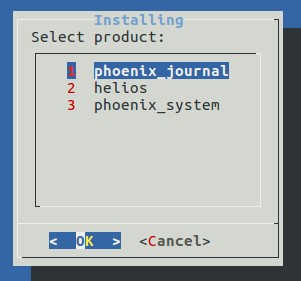
After that preferred version of Smilart Phoenix Journal can be selected.
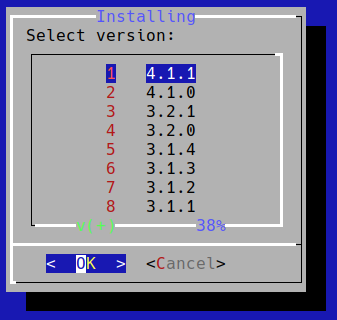
Screen with information about selected version appears.
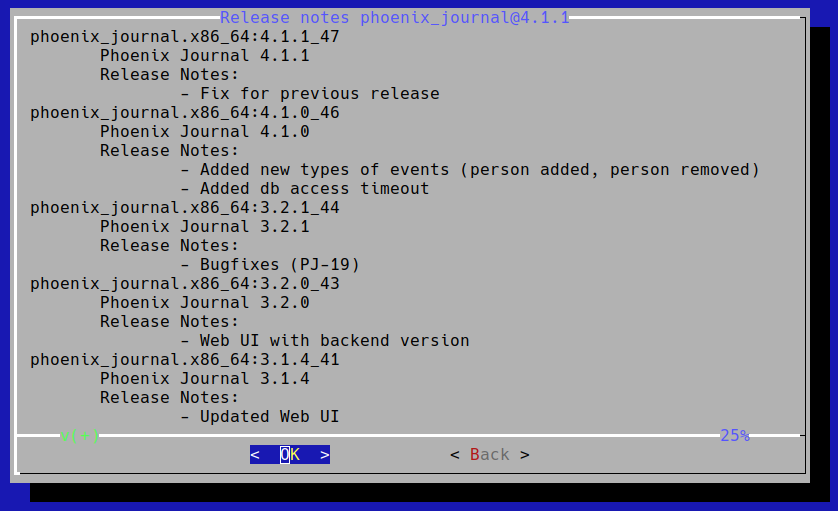
After confirmation system will collect information about the installation, download necessary files and offer to install collected images into the system.
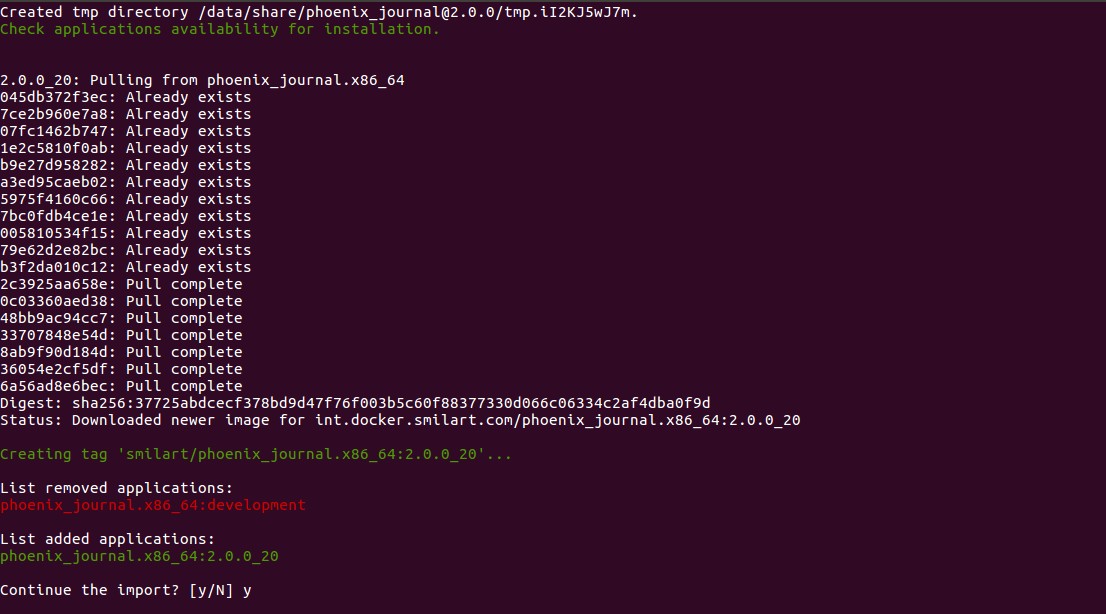
After confirmation system will complete the installation of Smilart Phoenix Journal.
Successful installation can be verified by using
$ sam list
List apps:
Name | Version | Repository
-----------------------------------------------------------------
phoenix_journal.x86_64 | 4.5.1_55 | int
...
| If any errors occur during the installation contact technical support. |
User interface
Smilart Phoenix Journal provides a basic user interface which can be found at http://<hostname>:8084/, where <hostname> is a hostname or ip-address of the server where journal is installed.
This interface can be used to find and display events stored in journals' database. It also provides capabilities to filter displayed events by date and time, type of event, camera or person id.
All events are sorted from newest to oldest.
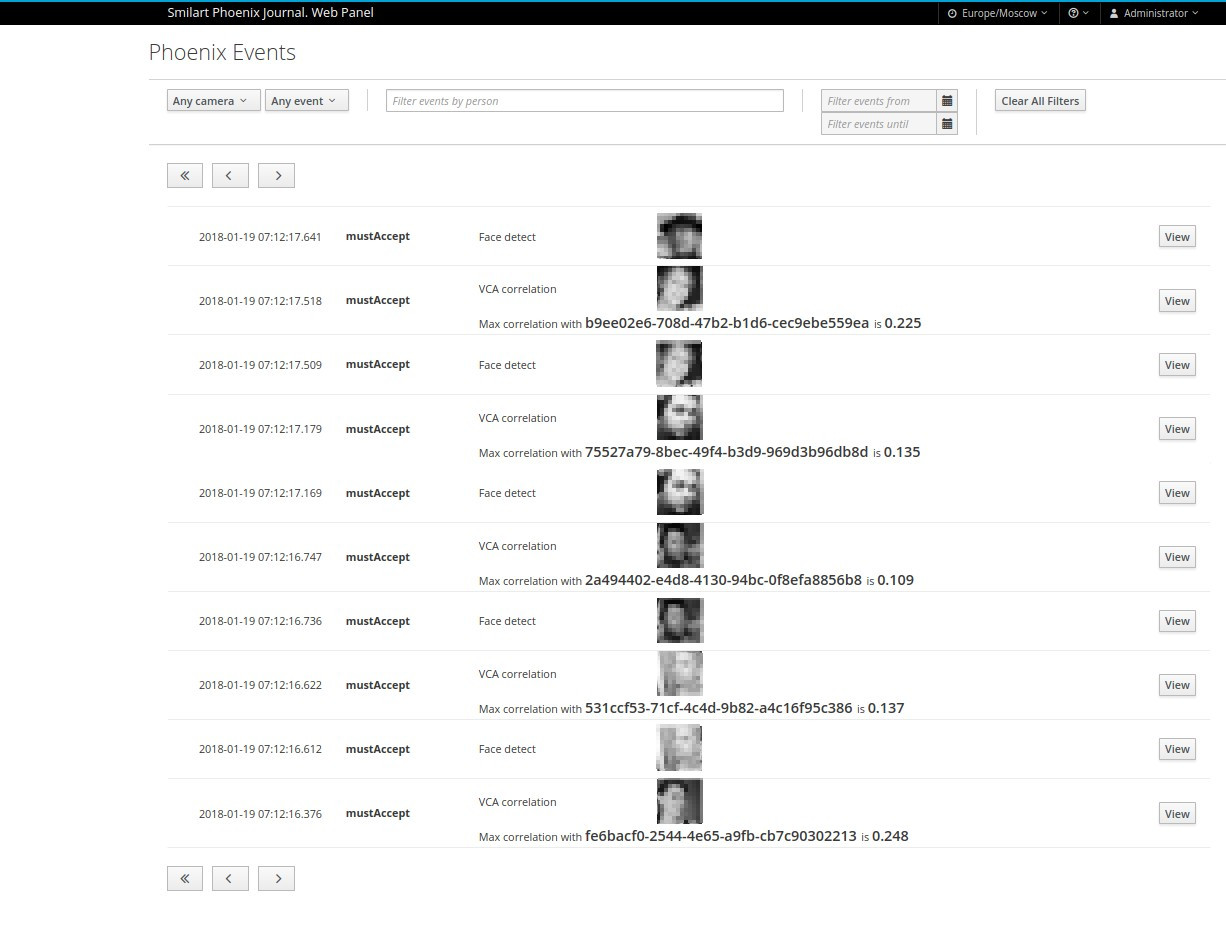
Configuration
Configuration file for Smilart Phoenix Journal is located at /etc/phoenix_journal/current/sys.config.
Text after % is a comment.
[
{sml_phoenix_journal, [
{web_panel, [
%% {authentication, none | {keycloak, #{...}} }
{authentication,
none
% {keycloak, #{
% host=> "${keycloak_host}",
% role=> "phoenix_journal_auditor",
% port=> 8080,
% client_id=> "phoenix_journal_web_panel",
% realm=> "smilart"
% }}
},
{port, "${WEB_PANEL_PORT}"}
]},
{phoenix_connection, [
{node, 'sml_phoenix@phoenix'}, %% Erlang node name
{cookie, 'sml_phoenix'} %% Cookie
]},
{max_db_size_gb, 20},
{max_retained_correlation_photos, 4},
{db_partition_backup_timeout_sec, 180},
{user_request_timeout_ms, 15000},
{path, "/data/phoenix_journal/journal_db/"},
{db_access_timeout_sec, 15},
{save_frames, [
{verification, [
{enabled, false},
{frames_throttle_time_ms, 100}
]}
]}
]},
{cache, [
{event_cache, [{n, 10}, {ttl, 60}]},
{detect_cache, [{n, 10}, {ttl, 300}]}, %ttl in sec
{read_cache, [{n, 10}, {ttl, 300}]},
{person_cache, [{n, 10}, {ttl, 1200}]}
]},
{lager, [
{async_threshold, 100},
{async_threshold_window, 25},
{crash_log_size, 104857600},
{crash_log_date, ""},
{crash_log_count, 4},
{handlers, [
%{lager_file_backend, [{file, "log/debug.log"}, {level, debug}, {size, 104857600}, {date, ""}, {count, 4}]},
{lager_file_backend, [{file, "log/info.log"}, {level, info}, {size, 104857600}, {date, ""}, {count, 4}]},
{lager_file_backend, [{file, "log/warning.log"}, {level, warning}, {size, 104857600}, {date, ""}, {count, 4}]},
{lager_file_backend, [{file, "log/error.log"}, {level, error}, {size, 104857600}, {date, ""}, {count, 4}]}
]}
]},
{sasl, [
{sasl_error_logger, {file, "log/sasl_errors.log"}},
{errlog_type, error}
]}
].
Phoenix connection settings
The section phoenix_connection contains Phoenix connection settings.
Name |
Type |
Description |
node |
string |
Phoenix node name in {NAME}@{HOST} format. |
cookie |
string |
Phoenix erlang cookie. |
Web panel settings
The section web_panel contains Web Panel settings.
Name |
Type |
Description |
authentication |
|
Describes what authentication method will be used by Web Panel to access Phoenix Journal. |
port |
string |
On which port Web Panel will be available. |
Phoenix Journal Db settings
This section contains settings for Phoenix Journal Database.
Name |
Type |
Description |
max_db_size_gb |
integer |
Maximum size of journal database in gigabytes. |
max_retained_correlation_photos |
integer |
Maximum number of top correlated photos per event to store in Journal database. |
db_partition_backup_timeout_sec |
integer |
Timeout in seconds to backup one partition of Journal database. |
user_request_timeout_ms |
integer |
Timeout in milliseconds to obtain data for UI from Journal database. |
db_access_timeout_sec |
integer |
Timeout in seconds to access Journal database. |
path |
string |
Where in filesystem Journal database files will be stored. |
Any settings not described above should be changed only by developers.
Phoenix Events settings
This section contains settings for some external Phoenix Events.
Name |
Type |
Description |
save_frames |
object |
Settings to save frames from cameras to Journal database. |
save_frames.verification |
object |
Settings to save camera frames during verification process to Journal database. |
save_frames.verification.enabled |
boolean |
Setting whether to save frames camera frames during verification process to Journal database. |
save_frames.verification.frames_throttle_time_ms |
integer |
Minimum time interval in milliseconds between saving camera frame events to Journal database. |
save_frames.verification.enabled can be true only for the period of debugging the quality of the system.Low value of save_frames.verification.frames_throttle_time_ms can affects system performance and accelerates events rotation in Journal database.
|
User interface settings
By default there is no authorization for User interface, but it is possible to add some.
-
By using Nginx basic authorization.
-
By using Keycloak (https://www.keycloak.org/).
Secure User interface with Nginx basic access authentication
Install and setup Nginx (https://smilart.atlassian.net/wiki/spaces/PS/pages/173670407/Install+nginx+for+basic+access+authentication).
For instance we want to have access to User Interface by http://nginx-address/journal/. And assume that Nginx can get User Interface by http://192.168.1.39:8084
To achieve that you must modify /etc/nginx/nginx.conf by adding location rules to your http server which is on port 80.
#...
http {
#...
server {
listen 80;
#...
# Next rule is to get User Interface resources files
location /journal/ {
proxy_pass http://192.168.1.39:8084/; # note the trailing slash!
}
# Next is used for internal Journal API
location /journal/api/csi {
proxy_pass http://192.168.1.39:8084/api/csi;
proxy_http_version 1.1;
proxy_set_header Upgrade $http_upgrade;
proxy_set_header Connection "upgrade";
proxy_read_timeout 2073600; #maximum supported is 24 days
}
#...
}
}
#...
To Apply changes in the config file Nginx must be restarted by systemctl restart nginx.
|
After that follow next steps to close Journal User Interface port:
1) Create file /var/lib/iptables/rules-save and edit like in example below.
*filter
-A INPUT -p tcp -m tcp --dport 8084 -j DROP
COMMIT2) Enable iptables-restore systemctl enable iptables-restore.
3) Reboot.
Secure User Interface with Keycloak
Install and setup Keycloak (https://smilart.atlassian.net/wiki/spaces/PS/pages/164102281/Install+keycloak).
Change Journal config parameter web_panel (/etc/phoenix_journal/current/sys.config.orig)
% - makes comment until end of line
% ...
{web_panel, [
%% {authentication, none | {keycloak, [ ...]} }
{authentication,
{keycloak, [
{host, "${keycloak_host}"},
{port, 8080},
{role, "phoenix_journal_auditor"},
{client_id, "phoenix_journal_web_panel"},
{realm, "smilart"}
]}
},
{port, "${WEB_PANEL_PORT}"}
]},
% ...Name |
Type |
Description |
web_panel |
object |
Settings for User Interface. |
web_panel.port |
integer |
User Interface port . By default will be applied from env. |
web_panel.authentication |
object |
Can be |
web_panel.authentication.keycloak.host |
string |
Host name of Keycloak. By default will be applied from env. |
web_panel.authentication.keycloak.port |
integer |
Port of Keycloak. By default |
web_panel.authentication.keycloak.role |
string |
Required role for Keycloak user to access Admin Panel. By default |
web_panel.authentication.keycloak.client_id |
string |
Name of Keycloak 'Client' for Admin Panel. By default |
web_panel.authentication.keycloak.realm |
string |
Keycloak realm to use. By default |
| If you change User Interface port you also need to change this port forwarding in systemd unit file (/etc/systemd/system/phoenix_journal.service). |
Host name and port of Keycloak must be reachable from phoenix_journal docker container and from client side of User Interface.
|
To Apply changes in the config Journal must be restarted by systemctl restart phoenix_journal.
|
Backup and Restore
Backuping journal database can be done by invoking sml_phoenix_journal_backup from /opt/bin
/opt/bin/sml_phoenix_journal_backup --path <path>
Here <path> is the path to where database files will be dumped. This path must be attached as a volume to Phoenix Journal docker container.
Restoring journal database can be done by invoking sml_phoenix_journal_restore from /opt/bin
/opt/bin/sml_phoenix_journal_restore --path <path>
Here <path> is the path from where database files will be copied. This path must be attached as a volume to Phoenix Journal docker container.
The path /data/share is attached to Phoenix Journal container by default and can be used for backup and restore purposes.
Tips
To drop database stop journal, delete database files in /data/phoenix_journal and start journal back.
It will create clean database on startup.
To change database size stop journal, change database size in sys.config and drop database before starting journal.